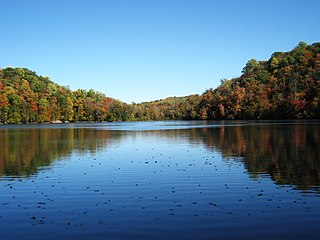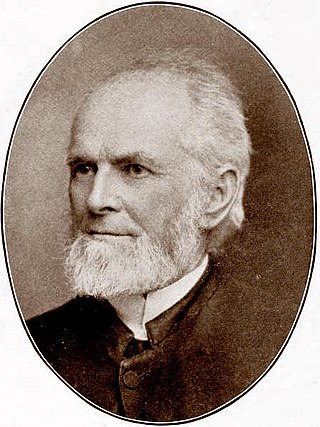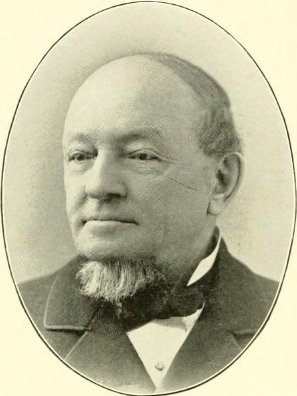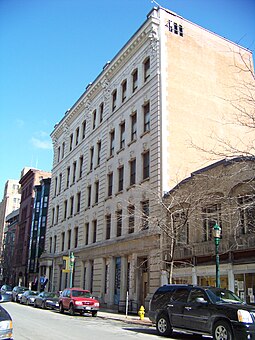
Syracuse is a city in and the county seat of Onondaga County, New York, United States. With a population of 148,620 and a metropolitan area of 662,057, it is the fifth-most populated city and 13th-most populated municipality in the state of New York.

Onondaga County is a county in the U.S. state of New York. As of the 2020 census, the population was 476,516. The county seat is Syracuse. The county is part of the Central New York region of the state.

Liverpool is a lakeside village in Onondaga County, New York, United States. As of the 2020 census, the population was 2,242. The name was adopted from the city of Liverpool in the United Kingdom. The village is on Onondaga Lake, in the western part of the town of Salina and is northwest of Syracuse, of which it is a suburb.

The Onondaga people are one of the five original nations of the Haudenosaunee (Iroquois) Confederacy in the Northeastern Woodlands. Their historical homelands are in and around present-day Onondaga County, New York, south of Lake Ontario.

Onondaga Lake is located in Central New York, immediately northwest of and adjacent to Syracuse, New York. The southeastern end of the lake and the southwestern shore abut industrial areas and expressways; the northeastern shore and northwestern end border a series of parks and museums.

The Diocese of Syracuse is a Latin Church ecclesiastical territory, or diocese, of the Catholic Church in Upstate New York in the United States. Its episcopal see is located in Syracuse. It is a suffragan diocese in the ecclesiastical province of the metropolitan Archdiocese of New York.

Sainte-Marie among the Hurons was a French Jesuit settlement in Huronia or Wendake, the land of the Wendat, near modern Midland, Ontario, from 1639 to 1649. It was the first European settlement in what is now the province of Ontario. Eight missionaries from Sainte-Marie were martyred, and were canonized by the Catholic Church in 1930. Sainte-Marie Among the Hurons was designated a National Historic Site of Canada in 1920. A reconstruction of the mission now operates as a living museum.
Father Simon Le Moyne, S.J., sometimes spelled Simon Le Moine, was a French Jesuit priest who became involved with the mission to the Hurons and Iroquois in the Americas. Le Moyne had acquired sixteen years of education and experience through priesthood in France before his arrival in New France in 1638. During that same year, he headed out to his mission in Huron country. The destruction of the Huron nation by the Iroquois brought him back east to what is modern day Quebec in 1650.

William Martin Beauchamp was an American ethnologist and Episcopal clergyman. He published several works on the archeology and ethnology of the Haudenosaunee (Iroquois) in New York.

Sainte Marie among the Iroquois was a 17th-century French Jesuit mission located in the middle of the Onondaga nation of the Iroquois. It was located on Onondaga Lake near modern-day Syracuse, New York. The original mission, led by Jesuit priest Simon Le Moyne, was in use only from 1656 to 1658.
Historic preservation in New York is activity undertaken to conserve forests, buildings, ships, sacred burial grounds, water purity and other objects of cultural importance in New York in ways that allow them to communicate meaningfully about past practices, events, and people.
The story of the city of Syracuse began with the land which was covered with swamps and bogs, and with a large forest surrounding a clear, freshwater lake located in the northeast corner of the Finger Lakes Region. The land around the present day city was originally the home of the Haudensaunee, or the Onondaga Nation. They were members of the Iroquois Confederacy, which spanned most of Upstate New York.

Clinton Square is an intersection in downtown Syracuse, New York, United States. The square was the original town center and first came into existence in the early 19th century where roadways from north and south convened. With the opening of the Erie Canal in 1825 the intersection was further transformed. During the 19th century, the square was a marketplace that also hosted several public events, including an 1870 public barbecue reportedly attended by 20,000 people.
Syracuse is a city in Central New York sited on the former lands of the Onondaga Nation. Officially incorporated as a village in 1825, it has been at a major crossroads over the last two centuries, first of the Erie Canal and its branch canals, then on the railway network. The city grew on the back of its salt and chemical industries, and later as a center of manufacturing and engineering. Although its industries have dwindled, the city has remained the economic and educational hub of Central New York, a region with over a million inhabitants; the population of the city, though, has been in decline since peaking in the 1950s.

The Onondaga Creekwalk is a mostly paved, partly bricked, multi-use trail running 4.8 miles (7.7 km) in Syracuse, New York, which has so far seen more than three decades of planning, construction, and delays, starting in 1988. The trail is designed for bicyclists, skaters, and pedestrians to approximately parallel any desired portion of Onondaga Creek's run connecting Kirk Park on Syracuse's South Side, downstream through downtown at Armory Square, and then on to Onondaga Lake at the creek's ultimate mouth.

John Buck, titled Skanawati among other variants, was a leader of the Onondaga who lived near Ontario's Grand River. He was the official keeper of the wampum records of the Iroquois, sometimes described as a firekeeper. He took on the role of wampum keeper in 1843. Buck was described in a contemporary account as "a capable ruler and an able and trustworthy negotiator". Kenyon and Kenyon identify him as a "follower of Handsome Lake".

John Manchester Wieting was an American lecturer and philanthropist. He spent his early years as a teacher and then as an engineer and grader. After moving to Syracuse, New York, he read medicine to become a physician. After purchasing anatomical models he began giving lectures across upstate New York, gradually expanding the reach and the size of his lectures. They were extravagant affairs, and Wieting became known as one of the era's most prominent anatomical lecturers.

Mary Elizabeth Wieting Johnson was an American opera house manager and philanthropist who ran the Wieting Opera House in Syracuse, New York, after the death of her husband, John Wieting. She oversaw management of the Wieting Opera House and its reconstruction after it burned down for the third time in 1896.

The Bastable Theatre was a theatre in Syracuse, New York, from 1893 to 1923, when it burnt down. First built by Frederick Bastable, Sam S. Shubert began his theatre management at the Bastable in 1897. He and his brothers established The Shubert Organization, which became a major theatre owner. During Shubert's early years of management, he competed with the city's Wieting Opera House, which was controlled by The Theatrical Syndicate. The Bastable itself hosted a number of touring companies in the city and became known for hosting stock companies and melodramas. The State Tower Building was constructed on the site of the theatre after it burnt down.















